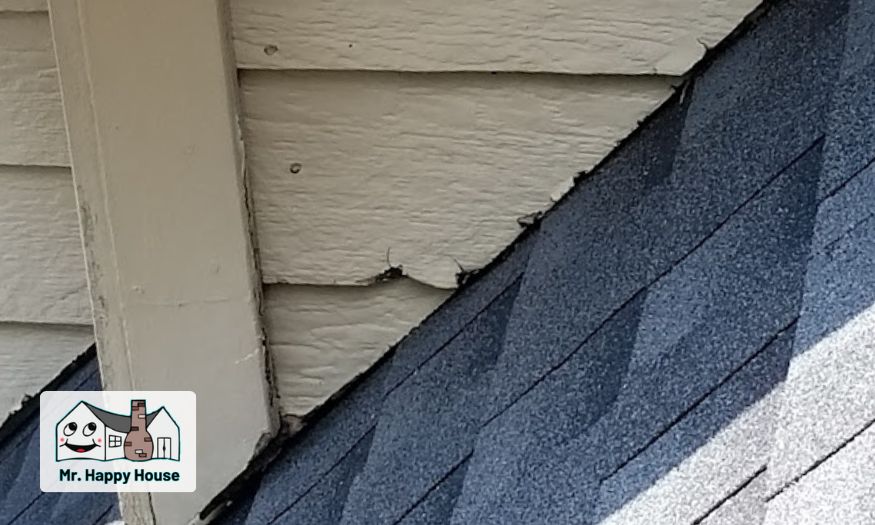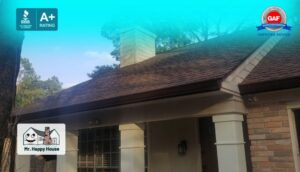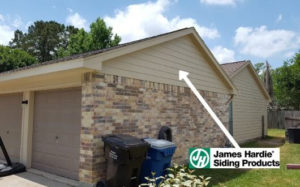
Best GAF Certified Roofers in The Woodlands, TX – Quality Roof Replacement, Gutters & Siding
Best GAF Certified Roofers in The Woodlands, TX – Quality Roof Replacement, Gutters & Siding Best GAF Certified Roofers in The Woodlands, TX – Quality

If the siding on your home is crumbling and falling apart, you may ask yourself, is it better to repair or replace siding?
The siding on your home serves as one of the main protectors for keeping animals, debris, and the outside elements out, and it also serves as the main point of curb appeal. Having good looking siding that will hold the test of time against storms, rain, and other elements is critical to preserving your home’s value.
In this article, we will dive into whether or not you should repair or replace your home’s siding, exploring the nuances of siding damage, the benefits of siding repair versus replacement, and the various factors that will better help you in this decision. Whether you’re faced with a few cracks and chips or extensive structural issues, understanding the options available can empower you to make informed choices about the future of your home’s exterior and siding.
Siding damage on your home isn’t always immediately apparent, but its consequences can be far-reaching. Identifying the signs of siding deterioration is the first step in determining whether repair or replacement is necessary.
Before rushing into a full siding replacement, you as the homeowner should consider the potential benefits of repairing existing siding. While extensive damage may necessitate replacement, many issues can be addressed through targeted repairs, offering several advantages:
Note: if you’re looking for a siding contractor in The Woodlands to repair your siding, Mr. Happy House does not do single board replacements, for a siding repair, we must replace the entire section of the damaged area for the best results and curb appeal.
While repairing siding offers several benefits, it’s essential to assess the extent of damage and consult with a qualified siding professional to determine the most appropriate course of action. In some cases, extensive or widespread damage may necessitate a full replacement to ensure the long-term stability and aesthetics of the home’s exterior.
Nonetheless, exploring repair options can provide you as the homeowner with valuable insights into cost-effective maintenance strategies and help maximize the lifespan of your home siding.
While repairing siding can offer cost-effective solutions for minor damage, there are situations where replacement becomes necessary to maintain the structural integrity and aesthetics of a home’s exterior.
Several factors may indicate that a full siding replacement is the most appropriate course of action:
Severe or Widespread Damage: Extensive damage, such as large areas of rot, widespread warping, or significant cracks, may compromise the structural stability of siding panels and the underlying structure of the home. In such cases, patchwork repairs may be insufficient to address the underlying issues, in which, in this scenario, the best time to replace your siding is at that moment of severe damage.
Aging Siding: As siding ages, especially wood siding, which tends to rot, it becomes more susceptible to deterioration from environmental factors, wear and tear, and exposure to the elements. Over time, the protective qualities of the siding may diminish, leading to increased vulnerability to damage and decay. If siding has reached the end of its expected lifespan or shows signs of advanced deterioration, which is noted here in the article about the signs of siding damage, a full siding replacement is the best route to take.
Desire for a New Look or Material: You may opt for siding replacement to update the appearance of your home or to switch to a different siding material that offers improved durability, energy efficiency, or aesthetic appeal.
Whether seeking a contemporary design, enhancing curb appeal, or addressing maintenance concerns, replacing siding provides an opportunity to customize the exterior of the home to better suit personal preferences and functional requirements.
With James Hardie Siding becoming more popular in new home builds due to its long term durability and aesthetic appeal, a full siding replacement could vastly increase the value of your home, if you intend on selling it in the near future.
Although full replacement might be a large investment upfront, it offers long-term benefits in terms of improved durability, enhanced aesthetics, and increased property value. By addressing underlying issues and upgrading to modern siding materials, homeowners can ensure the longevity and attractiveness of their home’s exterior for years to come.
Consulting with siding professionals can help homeowners assess the condition of their existing siding and determine whether replacement is necessary to achieve their maintenance and renovation goals.
The decision to repair or replace your siding is also influenced by various factors that you as a homeowner should carefully consider before taking action. Understanding these factors can help homeowners make informed choices that align with your home renovation budget, aesthetic preferences, and long-term maintenance goals:
Cost Considerations: One of the primary factors influencing the decision is the cost associated with repair versus replacement. While repairs are generally more affordable in the short term, extensive damage or recurring issues may result in higher long-term costs. Replacement, although initially more expensive, can provide a more durable and cost-effective solution by addressing underlying issues and improving the overall condition of the home’s exterior.
Material Availability and Compatibility: The availability of matching siding materials and the compatibility of new materials with existing components can impact the feasibility of repair versus replacement. In some cases, sourcing identical siding materials for repairs may be challenging, leading homeowners to consider replacement options that offer greater design flexibility and compatibility with modern construction standards.
Long-Term Goals for the Property: As a homeowner, you should consider your long-term goals for your home and property when deciding between repair and replacement. Factors such as resale value, energy efficiency, and maintenance requirements can influence this decision.
Investing in a full siding replacement may offer greater returns in terms of improved curb appeal, enhanced energy efficiency, and reduced maintenance costs over time.
Extent of Damage and Future Risk: Assessing the extent of siding damage and the potential for future issues is crucial in determining whether repair or replacement is necessary. While minor damage may be effectively addressed through repairs, extensive or recurring damage may indicate underlying structural issues that require more comprehensive solutions.
Homeowners should consult with siding professionals to conduct a thorough inspection and evaluate the overall condition of the siding before making a decision.
By carefully weighing these factors and consulting with experienced siding professionals such as Mr. Happy House, homeowners can make informed decisions that ensure the longevity, aesthetics, and structural integrity of their home’s exterior.
Whether opting for targeted repairs or a complete replacement, proactive maintenance and strategic planning can help homeowners safeguard their investment and enhance the beauty and value of their property.
Deciding whether to hire professionals or undertake siding repairs or replacement as a do-it-yourself (DIY) project requires careful consideration of various factors. While DIY enthusiasts may be tempted to tackle siding projects themselves to save on costs, there are advantages and disadvantages to both approaches (more disadvantages when doing it yourself):
Deciding whether to repair or replace siding is a critical decision that can impact the appearance, durability, and value of your home. Throughout this article, we’ve explored the various factors that influence this decision, from the extent of siding damage to cost considerations and long-term maintenance goals.
Whether your siding is showing signs of wear and tear or you’re considering an upgrade for aesthetic or functional reasons, it’s essential to approach the decision thoughtfully and strategically. By understanding the benefits of repairing versus replacing siding and considering factors such as material availability, future risk, and professional expertise, you can make informed choices that align with your budget and objectives.
While repairing siding may offer short-term cost savings, replacement provides an opportunity to address underlying issues, upgrade to modern materials, and enhance the overall appearance and performance of your home’s exterior. Consulting with experienced siding professionals can help you assess the condition of your siding, explore available options, and develop a tailored plan that meets your needs and goals.
Ultimately, investing in the maintenance and renovation of your home’s siding is an investment in the long-term integrity, beauty, and value of your property. Whether you want to aim for targeted repairs or a complete replacement, proactive maintenance and strategic planning can help you protect your investment and enjoy a beautiful, well-maintained home for years to come.
We hoped you loved this article on if it's better to repair or replace siding on your home, please share and tune in for more roofing, siding, and house painting content!
Our Services:













Best GAF Certified Roofers in The Woodlands, TX – Quality Roof Replacement, Gutters & Siding
Best GAF Certified Roofers in The Woodlands, TX – Quality Roof Replacement, Gutters & Siding Best GAF Certified Roofers in The Woodlands, TX – Quality

Are Gutters Part of the Roofing System?
Are Gutters Part of the Roofing System? Are Gutters Part of the Roofing System? When it comes to home maintenance, gutters often seem like a

Why James Hardie is The Best Option for Home Siding
Why James Hardie is The Best Option for Home Siding Why James Hardie is The Best Option for Home Siding James Hardie stands out whether











